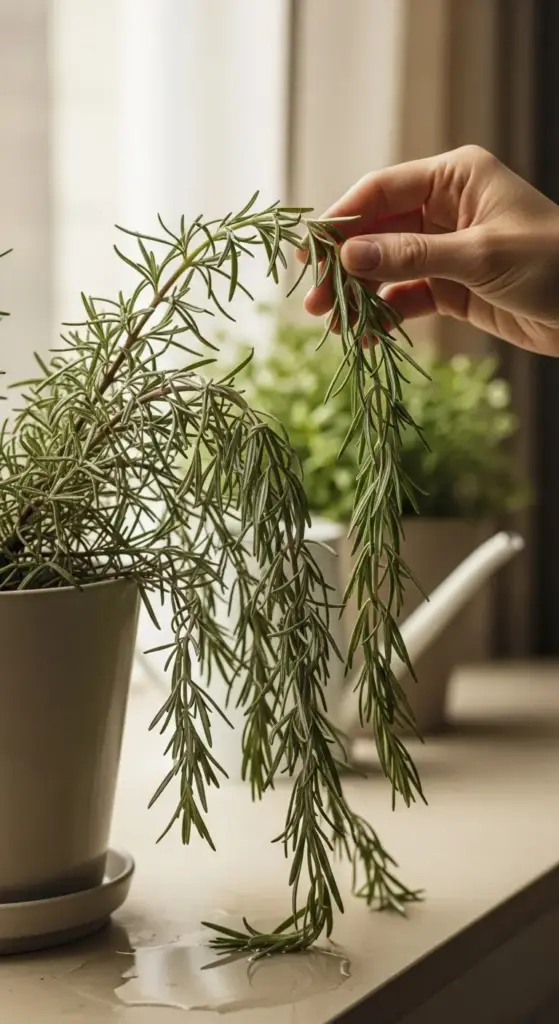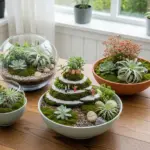4. Drooping or Wilting Despite Moist Soil

I’ll never forget the panic I felt when my rosemary started looking like a sad, wilted mess even though I’d been so careful about keeping the soil moist. My first instinct? Water it more, obviously.
Worst decision ever. That poor plant was basically drowning, and I was throwing it a life preserver made of… more water.
The Overwatering Trap That Catches Most Beginners
Here’s the overwatering trap that gets everyone: we think droopy leaves always mean thirsty plants. But with rosemary, drooping despite moist soil usually means the roots are suffocating.
I spent weeks adding more water to my wilting rosemary before I finally stuck my finger deep into the soil. It was like a swamp down there.
Root suffocation happens when soil stays too wet for too long. Roots need oxygen just like we do, and waterlogged soil basically cuts off their air supply.
The confusing part? Overwatered rosemary looks almost identical to underwatered rosemary at first. Both cause drooping, wilting, and sad-looking leaves.
The difference is in the soil. Underwatered plants have dry, pulling-away-from-the-pot soil. Overwatered plants have that heavy, soggy soil that smells funky when you dig into it.
How Different Pot Materials Affect Soil Moisture Retention
This one took me way too long to figure out. I had my rosemary in this gorgeous ceramic pot that I thought was perfect. Turns out, it was a moisture-trapping nightmare.
Plastic pots hold moisture the longest – sometimes too long for rosemary’s liking. I’ve learned they work okay in really dry climates, but in humid areas, they’re basically creating a swamp.
Terracotta pots are rosemary’s best friend. The clay actually breathes and wicks moisture away from the roots. I switched all my herbs to terracotta after my ceramic pot disaster.
Glazed ceramic looks pretty but acts like plastic – no breathability at all. The soil in my ceramic pots stayed wet for twice as long as the same soil in terracotta.
Metal pots? Don’t even get me started. They heat up in the sun and create this weird steam-bath effect that rosemary absolutely hates.
Size matters too. A small plant in a huge pot means tons of wet soil around a tiny root system. Recipe for disaster.
Signs of Root Suffocation and Poor Drainage
Root suffocation has some telltale signs once you know what to look for. The leaves don’t just droop – they get this weird, limp quality like they’ve given up on life.
The smell test never lies. Healthy soil smells earthy and fresh. Waterlogged soil smells sour, musty, or sometimes like rotten eggs. Trust your nose on this one.
Check the drainage holes in your pot. If water sits in the saucer for more than an hour after watering, you’ve got poor drainage issues.
Fungus gnats are another dead giveaway. Those tiny flies hovering around your plant? They love wet, oxygen-poor soil. I learned to see them as little warning flags.
The ultimate test? Gently unpot your plant and look at the roots. Healthy roots are white or light tan. Suffocated roots turn brown, black, or mushy.
Emergency Repotting Techniques for Waterlogged Plants
When I finally realized my rosemary was drowning, I had to act fast. Emergency repotting isn’t fun, but it’s often the only way to save a waterlogged plant.
First step: stop watering immediately. I know it’s tempting to “help,” but more water is the last thing your plant needs right now.
Gently remove the plant from its pot and shake off as much wet soil as possible. Don’t be afraid to be a little rough – you’re trying to save its life here.
Trim away any black or mushy roots with clean scissors. I know it looks scary, but those roots are already dead and will just spread rot to healthy parts.
Fresh, dry potting mix is essential. Don’t reuse any of the old soil – it’s contaminated with whatever caused the problem in the first place.
Choose a smaller pot if the root system is significantly reduced after trimming. A huge pot with a tiny root system will just create the same waterlogging problem again.
Choosing the Right Soil Mix for Your Climate Zone
Soil mix selection varies way more by climate than I ever realized. What works in dry Colorado will kill plants in humid Florida.
For humid climates, I mix regular potting soil with extra perlite and coarse sand. About 30% drainage material to 70% potting soil works well in places like Atlanta or Seattle.
Dry climates can handle richer, more moisture-retentive mixes. I use straight potting soil with maybe 10% perlite added in places like Phoenix or Denver.
Cactus soil mix is actually perfect for rosemary in most climates. It’s designed to drain quickly while still holding some moisture.
DIY soil mix that works everywhere: equal parts potting soil, perlite, and coarse sand. Add a handful of small gravel at the bottom of the pot for extra drainage insurance.
Never use garden soil in containers – it’s too heavy and doesn’t drain well enough. I learned this after creating several plant graveyards with “free” dirt from my yard.
The pH level matters too. Rosemary likes slightly alkaline soil, so I add a pinch of lime to acidic potting mixes. Most commercial mixes are fine as-is, though.
Test your drainage before planting by watering the empty pot with your soil mix. Water should flow through within a few minutes, not sit on top or drain super slowly.
Ready to spot the next sneaky problem? Click “next” to learn why those crispy brown leaf tips might be telling you something completely different than you think – and the winter mistake that nearly killed my entire herb collection!









GIPHY App Key not set. Please check settings